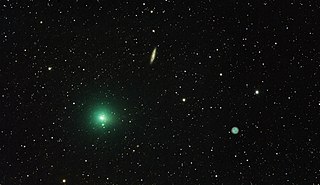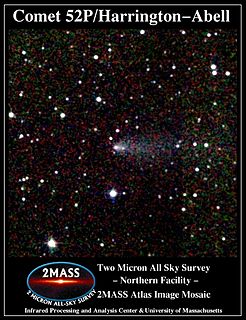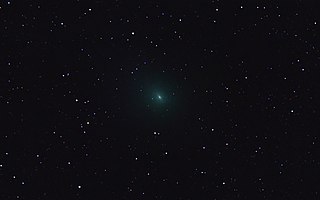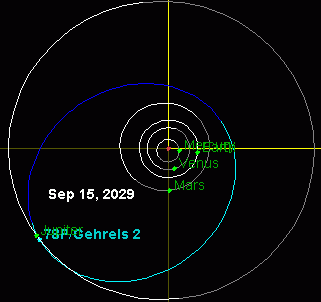4P/Faye is a periodic Jupiter-family comet discovered in November 1843 by Hervé Faye at the Royal Observatory in Paris. It last came to perihelion on May 29, 2014, and will next come to perihelion on September 8, 2021.
10P/Tempel, also known as Tempel 2, is a periodic Jupiter-family comet with a 5 year orbital period. It was discovered on July 4, 1873 by Wilhelm Tempel. The next perihelion passage is 24 March 2021 when the comet will have a solar elongation of 30 degrees at approximately apparent magnitude 11. Closest approach to Earth during the 2021 passage will not occur until many months later on 3 November 2021 at a distance of 1.6 AU (240 million km).
28P/Neujmin, also known as Neujmin 1, is a large periodic comet in the Solar System. With a perihelion distance of 1.5AU, this comet does not make close approaches to the Earth.

41P/Tuttle–Giacobini–Kresák is a periodic comet in the Solar System. The comet nucleus is estimated to be 1.4 kilometers in diameter.
48P/Johnson is a periodic comet in the Solar System.

52P/Harrington–Abell is a periodic comet in the Solar System.
60P/Tsuchinshan, also known as Tsuchinshan 2, is a periodic comet in the Solar System with an orbital period of 6.79 years. Tsuchinshan is the Wade-Giles transliteration corresponding to the pinyin Zĭjīn Shān, which is Mandarin Chinese for "Purple Mountain".

74P/Smirnova–Chernykh is a periodic comet in the Solar System. It fits the definition of an Encke-type comet with, and is a Quasi-Hilda comet. It was discovered in late March 1975 by Tamara Mikhajlovna Smirnova while examining exposures from the Crimean Astrophysical Observatory. In the discovery images the comet had an apparent magnitude of ~15. In the year of discovery, the comet came to perihelion on August 6, 1975.
111P/Helin–Roman–Crockett is a periodic comet in the Solar System. It was discovered by Eleanor and Ron Helin on 5 January 1989 from images obtained on the 3rd and 4th of that month. It is a Jupiter family comet known for extremely close approaches to Jupiter being a Quasi-Hilda comet. During these approaches, it actually orbits Jupiter. The last such approach was in 1976, the next will be in 2071. The Jovian orbits are highly elliptical and subject to intense Solar perturbation at apojove which eventually pulls the comet out of Jovian orbit for the cycle to begin anew.
138P/Shoemaker–Levy, also known as Shoemaker–Levy 7, is a faint periodic comet in the Solar System. The comet last came to perihelion on 11 June 2012, but only brightened to about apparent magnitude 20.5.

168P/Hergenrother is a periodic comet in the Solar System. The comet originally named P/1998 W2 returned in 2005 and got the temporary name P/2005 N2. The comet was last observed in February 2013, and may have continued fragmenting after the 2012 outburst.
171P/Spahr is a periodic comet in the Solar System. 171P/Spahr was recovered on 20–24 October 2011 at apparent magnitude 20.6 using the 2.0-metre (79 in) Faulkes Telescope South. 171P/Spahr is peaked at about magnitude 18 in 2012.
Comet Finlay is a periodic comet with an orbital period of 6 years discovered by William Henry Finlay on September 26, 1886. The next perihelion passage is July 13, 2021 when the comet will have a solar elongation of 54 degrees at approximately apparent magnitude 10. It last came to perihelion on December 27, 2014, at around magnitude 10. Of the numbered periodic comets, the orbit of 15P/Finlay has one of the smallest minimum orbit intersection distances with the orbit of Earth (E-MOID). In 2060 the comet will pass about 6 million km from Earth.

Comet Kopff or 22P/Kopff is a periodic comet in the Solar System. Discovered on August 23, 1906, it was named after August Kopff who discovered the comet. The comet was missed on its November 1912 return, but was recovered on its June 1919 return. The comet has not been missed since its 1919 return and its last perihelion passage was on May 25, 2009. Close approaches to Jupiter in 1938 and 1943 decreased the perihelion distance and orbital period. 22P/Kopff’s next perihelion passage is 18 March 2022.
Comet 30P/Reinmuth, also known as Comet Reinmuth 1, is a periodic comet in the Solar System, first discovered by Karl Reinmuth on February 22, 1928.
Comet Taylor, is a periodic comet in the solar system, first discovered by Clement J. Taylor on November 24, 1915.

45P/Honda–Mrkos–Pajdušáková is a short-period comet discovered by Minoru Honda December 3, 1948. It is named after Minoru Honda, Antonín Mrkos, and Ľudmila Pajdušáková. The object revolves around the Sun on an elliptical orbit with a period of 5.25 years. The nucleus is 1.3 kilometers in diameter. On August 19 and 20, 2011, it became the fifteenth comet detected by ground radar telescope.
206P/Barnard–Boattini was the first comet to be discovered by photographic means. The American astronomer Edward Emerson Barnard did so on the night of October 13, 1892.
43P/Wolf–Harrington is a periodic comet discovered on December 22, 1924, by Max Wolf in Heidelberg, Germany. In 2019 it passed within 0.065 AU of Jupiter, which lifted the perihelion point and increased the orbital period to 9 years.
62P/Tsuchinshan, also known as Tsuchinshan 1, is a periodic comet discovered on 1965 January 1 at Purple Mountain Observatory, Nanking.











